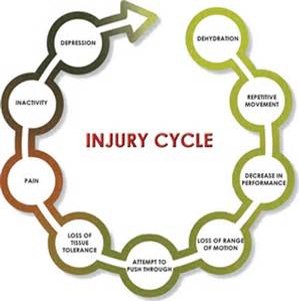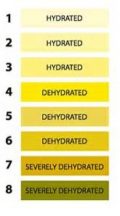Your Recovery Plan
The Objectives of Recovery and Regeneration 
1. Restore glycogen levels
2. Minimize the breakdown of muscle
3. Restore depleted electrolytes
4. Hydrate and Rehydrate
5. Offset the effects of free radicals
6. Reduce inflammation
7. Reduce muscle soreness
Have a post-exercise nutrition plan in place to consistently have recovery fuel options at your fingertips
WARNING: Waiting a few hours after workouts and competitions to eat and drink appropriate foods and fluids with energy delays exercise recovery. While you may not feel like a large meal or a lot of solid food right after training, getting used to a small snack or liquid recovery drink can be the difference-maker for many athletes, especially during heavy training periods. Recovery nutrition is a small nutritional habit that can have a huge impact on performance
- The ultimate goal of post-exercise refueling is to help you fully recover and prepare for the next practice or competition. Consistently consuming a mix of foods and fluids high in carbohydrates and protein (in the right amounts and at the right time) enables you to more rapidly prepare for exercise the next day. Prolonging post-exercise refueling stalls your body in a “breakdown” mode, taking it longer to recover once you do eat.

- Recovery is an essential component in sports training.
- The adaptation to training occurs during the recovery.
- Recovery is the process needed for repairing damage caused by training or competition.
Recovery Objectives
- Restore glycogen levels- to be effective carbohydrates should be taken within 2 hours after exercise.
- 1 gram of carbohydrate per kilogram of bodyweight per hour for the first two hours post exercise/post competition
- Minimize the breakdown of muscle- use a 1 to 4 ratio protein-carbohydrate
Restore depleted electrolytes- electrolyte replacement is crucial
- Sodium is the most important electrolyte as it is the one lost in sweat.
- Replacement of electrolytes can prevent heat illness, nausea, confusion, headaches, sleeplessness, post exercise fatigue, and muscle soreness.
- Avoid colas, coffee, tea, and alcohol
- Good choices- Water & sports drinks that contain sodium, foods high in water content, such as
 fruits, vegetables & soups
fruits, vegetables & soups
Hydrate and re-hydrate –Why is it so vital?
- The body is 60-65% water and performs many vital functions
1.Delivery of fuel to muscles
2.Lubricate & cushion joints
3.Shock absorption for the spine & brain
4.Regulate temperature
- Hydration will stabilize the blood volume and prevent muscle cramping
- Consume 16 oz. of water 2 hours prior to start of activity, then ½ hour prior consume 8 oz. of fluid combined with water & carbohydrates (Gatorade)
- During exercise 4-8 oz. every 15 min
Dehydration
- Occurs in a very short time, especially when exercising in hot weather.
- Fluids should be consumed before, during, and after
- Easy way to determine hydration, check the color of the urine (clear-pale yellow = Hydration)

Becoming dehydrated
- After a long workout, it can take 24-48 hours to replace fluids lost
- The body being hydrated is an important part of foam rolling
- Tendons, ligaments, and muscles all need to slide across each other with minimal friction.
- Without adequate water the tissues cannot slide freely, over time this will lead to less and less movement and increase the chances for injury.
- In order for foam rolling to be most effective, make sure to hydrate before and after rolling
Regeneration using a Foam Roller
This may add longevity to an athletes career!
- Foam rolling is a form of self-massage that can be beneficial for recovery and regeneration. It may alleviate soreness and make your muscles feel better.
- A foam roller is simply a cylindrical piece of hard-celled foam.
- The roller is used to apply longer sweeping strokes to long muscles groups such as calves, quads, hamstrings and also small areas like TFL, hip rotators, and glute medius
- The foam roller can be used on a daily basis
- When an athlete is done foam rolling he/she should feel better not worse.
Purpose:
- Foam rolling offers a great benefit both before and after a workout or competition
- Foam rollers are a small investment to see potentially significant decrease in soft tissue, non contact injuries and offer remarkable relief.
Below is an explanation and an image to get you going on your foam roller.

Hamstrings-
Balance on hands to work hamstrings from glute to knee
Turn toe slightly inward
Cross one foot over the other to emphasize more
Quads-
Balance on elbows face down with one quad on roller
Work your way up and down from hip to top of knee
To place greater emphasis on quad bend knee
Calves-
Balance on hands, roll from knee to just above ankle
Emphasize one side by crossing the leg over
Do this with toes pointed out and up
Peroneals-
Get into side plank position with roller on one shin
Shift body to apply pressure to anterior tibialis (muscle in front of shin)
roll from knee to ankle
Rolling to outside to get emphasis on peroneus
IT bands/Vastus Lateralis–
Start in side plank position with roller in middle of the thigh
Balance on forearm and bring top leg over to place on the floor
Roll slow to find “hot spots”
Change emphasis by putting bent leg on top of other leg
Upper Back-
Begin with roller around mid to upper back
Slowly roll to mid and upper back (shoulder blade area)
Roll right to left to emphasize one side
Hip Flexors-
Lie on far side of roller on one side hip complex
Slowly roll up and down
Adductors-
Balance on elbow and hand with one leg on roller
Slowly roll from knee to hip complex
